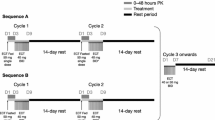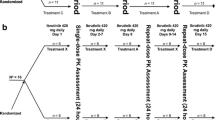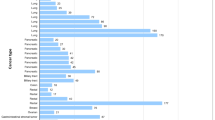Abstract
Purpose
Brivanib alaninate, an orally available prodrug of brivanib, is currently under evaluation for the treatment of several malignancies. This study aimed to (1) investigate effects of a high-fat meal on single-dose pharmacokinetics of brivanib in subjects with advanced/metastatic solid tumors and (2) assess the safety and preliminary efficacy of single and multiple doses of brivanib alaninate in this population.
Methods
A two-part study was conducted consisting of a single-dose phase (Part A) and a multiple-dose phase (Part B). In Part A, subjects received a single dose of brivanib alaninate (800 mg) either in a fasting state or following ingestion of a high-fat meal (approximately 951 kcal [15% protein, 33% carbohydrate, 52% fat]); serial blood samples were collected for pharmacokinetic analysis up to 48 h post-dosing. In Part B, subjects received brivanib alaninate (800 mg) once daily until discontinuation. Throughout both phases, subjects were evaluated for adverse events (AEs) and best clinical response.
Results
No clinically significant differences in brivanib exposure were observed between fed and fasting subjects in Part A; C max was unchanged and AUCINF decreased marginally when administered in a fed versus fasted state. In Part A, the incidence of treatment-emergent AEs was broadly similar in a fed or fasted state. Brivanib alaninate was generally well tolerated throughout the study and showed preliminary evidence of antitumor activity.
Conclusions
Consumption of a high-fat meal had no significant effect on brivanib pharmacokinetics. The study further demonstrates the acceptable safety/tolerability profile and antitumor potential of brivanib in patients with advanced malignancies.


Similar content being viewed by others
References
Kerbel RS (2008) Tumor angiogenesis. N Engl J Med 358(19):2039–2049
Motzer RJ, Michaelson MD, Redman BG, Hudes GR, Wilding G, Figlin RA, Ginsberg MS, Kim ST, Baum CM, DePrimo SE, Li JZ, Bello CL, Theuer CP, George DJ, Rini BI (2006) Activity of SU11248, a multitargeted inhibitor of vascular endothelial growth factor receptor and platelet-derived growth factor receptor, in patients with metastatic renal cell carcinoma. J Clin Oncol 24(1):16–24
Sandler A, Gray R, Perry MC, Brahmer J, Schiller JH, Dowlati A, Lilenbaum R, Johnson DH (2006) Paclitaxel-carboplatin alone or with bevacizumab for non-small-cell lung cancer. N Engl J Med 355(24):2542–2550
Escudier B, Eisen T, Stadler WM, Szczylik C, Oudard S, Siebels M, Negrier S, Chevreau C, Solska E, Desai AA, Rolland F, Demkow T, Hutson TE, Gore M, Freeman S, Schwartz B, Shan M, Simantov R, Bukowski RM (2007) Sorafenib in advanced clear-cell renal-cell carcinoma. N Engl J Med 356(2):125–134
Ellis LM, Hicklin DJ (2008) VEGF-targeted therapy: mechanisms of anti-tumour activity. Nat Rev Cancer 8(8):579–591
Llovet JM, Ricci S, Mazzaferro V, Hilgard P, Gane E, Blanc JF, de Oliveira AC, Santoro A, Raoul JL, Forner A, Schwartz M, Porta C, Zeuzem S, Bolondi L, Greten TF, Galle PR, Seitz JF, Borbath I, Haussinger D, Giannaris T, Shan M, Moscovici M, Voliotis D, Bruix J (2008) Sorafenib in advanced hepatocellular carcinoma. N Engl J Med 359(4):378–390
Cheng AL, Kang YK, Chen Z, Tsao CJ, Qin S, Kim JS, Luo R, Feng J, Ye S, Yang TS, Xu J, Sun Y, Liang H, Liu J, Wang J, Tak WY, Pan H, Burock K, Zou J, Voliotis D, Guan Z (2009) Efficacy and safety of sorafenib in patients in the Asia-Pacific region with advanced hepatocellular carcinoma: a phase III randomised, double-blind, placebo-controlled trial. Lancet Oncol 10(1):25–34
Welch S, Spithoff K, Rumble RB, Maroun J (2010) Bevacizumab combined with chemotherapy for patients with advanced colorectal cancer: a systematic review. Ann Oncol 21(6):1152–1162
Lee WJ, Lee JL, Chang SE, Lee MW, Kang YK, Choi JH, Moon KC, Koh JK (2009) Cutaneous adverse effects in patients treated with the multitargeted kinase inhibitors sorafenib and sunitinib. Br J Dermatol 161(5):1045–1051
Zangari M, Fink LM, Elice F, Zhan F, Adcock DM, Tricot GJ (2009) Thrombotic events in patients with cancer receiving antiangiogenesis agents. J Clin Oncol 27(29):4865–4873
Bhide RS, Cai ZW, Zhang YZ, Qian L, Wei D, Barbosa S, Lombardo LJ, Borzilleri RM, Zheng X, Wu LI, Barrish JC, Kim SH, Leavitt K, Mathur A, Leith L, Chao S, Wautlet B, Mortillo S, Jeyaseelan R, Kukral D, Hunt JT, Kamath A, Fura A, Vyas V, Marathe P, D’Arienzo C, Derbin G, Fargnoli J (2006) Discovery and preclinical studies of (R)-1-(4-(4-fluoro-2-methyl-1H-indol-5-yloxy)-5-methylpyrrolo[2, 1-f][1,2,4]triazin-6-yloxy)propan-2-ol (BMS-540215), an in vivo active potent VEGFR-2 inhibitor. J Med Chem 49(7):2143–2146
Huynh H, Ngo VC, Fargnoli J, Ayers M, Soreide O, Koong HN, Thng CH, Ong HS, Chow P, Pollock P, Byron S, Tran E (2008) Brivanib alaninate, a dual inhibitor of vascular endothelial growth factor receptor and fibroblast growth factor receptor tyrosine kinases, induces growth inhibition in mouse models of human hepatocellular carcinoma. Clin Cancer Res 14:6146–6153
Bhide RS, Lombardo LJ, Hunt JT, Cai ZW, Barrish JC, Galbraith S, Jeyaseelan R Sr, Mortillo S, Wautlet BS, Krishnan B, Kukral D, Malone H, Lewin AC, Henley BJ, Fargnoli J (2010) The antiangiogenic activity in xenograft models of brivanib, a dual inhibitor of vascular endothelial growth factor receptor-2 and fibroblast growth factor receptor-1 kinases. Mol Cancer Ther 9(2):369–378
Jonker DJ, Rosen LS, Sawyer MB, de Braud F, Wilding G, Sweeney CJ, Jayson GC, McArthur GA, Rustin G, Goss G, Kantor J, Velasquez L, Syed S, Mokliatchouk O, Feltquate DM, Kollia G, Nuyten DS, Galbraith S (2010) A phase I study to determine the safety, pharmacokinetics and pharmacodynamics of a dual VEGFR and FGFR inhibitor, brivanib, in patients with advanced or metastatic solid tumors. Ann Oncol. doi:10.1093/annonc/mdq599
Raoul J-L, Finn R, Kang YK, Park JW, Harris R, Coric V, Donica M, Walters I (2009) An open-label phase II study of first- and second-line treatment with brivanib in patients with hepatocellular carcinoma (HCC) [abstract]. J Clin Oncol 27(15s). Abstract 4577
Kane RC, Farrell AT, Saber H, Tang S, Williams G, Jee JM, Liang C, Booth B, Chidambaram N, Morse D, Sridhara R, Garvey P, Justice R, Pazdur R (2006) Sorafenib for the treatment of advanced renal cell carcinoma. Clin Cancer Res 12(24):7271–7278
Nexavar (prescribing information) (2009) Bayer HealthCare Pharmaceuticals, Wayne
Votrient (prescribing information) (2010) GlaxoSmithKline, Research Triangle Park
Zhu AX, Sahani DV, Duda DG, di Tomaso E, Ancukiewicz M, Catalano OA, Sindhwani V, Blaszkowsky LS, Yoon SS, Lahdenranta J, Bhargava P, Meyerhardt J, Clark JW, Kwak EL, Hezel AF, Miksad R, Abrams TA, Enzinger PC, Fuchs CS, Ryan DP, Jain RK (2009) Efficacy, safety, and potential biomarkers of sunitinib monotherapy in advanced hepatocellular carcinoma: a phase II study. J Clin Oncol 27(18):3027–3035
Launay-Vacher V, Deray G (2009) Hypertension and proteinuria: a class-effect of antiangiogenic therapies. Anticancer Drugs 20(1):81–82
Sutent (prescribing information) (2010) Pfizer Inc., New York
Nalluri SR, Chu D, Keresztes R, Zhu X, Wu S (2008) Risk of venous thromboembolism with the angiogenesis inhibitor bevacizumab in cancer patients: a meta-analysis. JAMA 300(19):2277–2285
Ranpura V, Hapani S, Chuang J, Wu S (2010) Risk of cardiac ischemia and arterial thromboembolic events with the angiogenesis inhibitor bevacizumab in cancer patients: a meta-analysis of randomized controlled trials. Acta Oncol 49(3):287–297
Choueiri TK, Schutz FA, Je Y, Rosenberg JE, Bellmunt J (2010) Risk of arterial thromboembolic events with sunitinib and sorafenib: a systematic review and meta-analysis of clinical trials. J Clin Oncol 28(13):2280–2285
Garrett C, Siu L, El-Khoueiry A, Buter J, Rocha-Lima C, Marshall J, Mokliatchouk O, Velasquez L, Syed S, Feltquate D (2008) A phase I study of brivanib alaninate (BMS-582664), an oral dual inhibitor of VEGFR and FGFR tyrosine kinases, in combination with full dose cetuximab (BC) in patients (pts) with advanced gastrointestinal malignancies (AGM) who failed prior therapy. J Clin Oncol 26(May suppl). Abstract 4111
Mekhail T, Masson E, Fischer B, Gong J, Iyer R, Gan J, Pursley J, Patricia D, Williams D, Ganapathi R (2010) Metabolism, excretion, and pharmacokinetics of oral brivanib in patients with advanced or metastatic solid tumors. Drug Metab Dispos (29 Jul, Epub ahead of print). doi:10.1124/dmd.110.033951
Acknowledgments
The authors would like to acknowledge the contributions of the enrolled patients and their families, as well as the nursing and data management staff who worked on this study. Additional bioanalytical support was provided by Janice Pursley (Bristol-Myers Squibb). In the development of this manuscript, editorial support was provided by Richard Daniel, PhD, of PAREXEL and was funded by Bristol-Myers Squibb. Grant support: Supported by research funding from Bristol-Myers Squibb (Study No. CA182022).
Conflict of interest
Patricia LoRusso: Declares the receipt of funding from GlaxoSmithKline.
Geoffrey I. Shapiro: No disclosures.
Herbert Hurwitz: Declares the provision of consultant/advisory services for Bristol-Myers Squibb and the receipt of funding from Bristol-Myers Squibb.
Mary Jo Pilat: No disclosures.
Janice Chemidlin: Employee of Bristol-Myers Squibb.
Georgia Kollia: Employee of Bristol-Myers Squibb; declares stock ownership in Bristol-Myers Squibb.
Shariq Syed: Employee of Bristol-Myers Squibb.
Bruce Fischer: Employee of Bristol-Myers Squibb; declares stock ownership in Bristol-Myers Squibb.
Eric Masson: Employee of Bristol-Myers Squibb; declares stock ownership in Bristol-Myers Squibb.
Author information
Authors and Affiliations
Corresponding author
Rights and permissions
About this article
Cite this article
LoRusso, P., Shapiro, G.I., Hurwitz, H. et al. Lack of food effect on single-dose pharmacokinetics of brivanib, and safety and efficacy following multiple doses in subjects with advanced or metastatic solid tumors. Cancer Chemother Pharmacol 68, 1377–1385 (2011). https://doi.org/10.1007/s00280-011-1603-2
Received:
Accepted:
Published:
Issue Date:
DOI: https://doi.org/10.1007/s00280-011-1603-2




